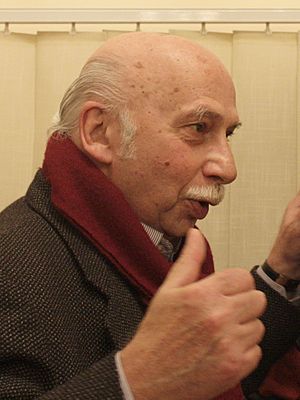Giya Kancheli facts for kids
Quick facts for kids
Giya Kancheli
PAU
|
|
|---|---|

Giya Kancheli photographed in March 2010
|
|
| Background information | |
| Born | 10 August 1935 Tiflis, Georgian SSR, Transcaucasian SFSR, USSR |
| Died | 2 October 2019 (aged 84) Tbilisi |
| Genres | Soundtrack, classical music |
| Occupation(s) | Composer |
| Instruments | Piano, keyboard, synthesizer |
| Years active | 1961–2019 |
| Associated acts | Jansug Kakhidze |
Giya Kancheli (Georgian: გია ყანჩელი) (born August 10, 1935 – died October 2, 2019) was a famous Soviet and Georgian composer. He was born in Tbilisi, Georgia. Later in his life, he lived in Belgium.
After the Soviet Union broke apart in 1991, Kancheli moved to Berlin. From 1995, he lived in Antwerp, Belgium. There, he became the main composer for the Royal Flemish Philharmonic orchestra. He passed away in his hometown of Tbilisi when he was 84 years old.
Contents
Giya Kancheli: A Master of Moods
Giya Kancheli was known for his special way of writing music. In his symphonies, which are long musical pieces for an orchestra, he often used slow, sad-sounding melodies. These melodies would play against long, quiet, and sometimes painful sounds from string instruments. Another famous composer, Rodion Shchedrin, once described Kancheli as someone who was very disciplined but also had a lot of strong feelings, like a volcano that is calm on the outside but powerful inside.
His Unique Music Style
Kancheli wrote seven symphonies. He also created a special piece for viola and orchestra called Mourned by the Wind. He called this piece a "liturgy," which usually means a religious service, but for him, it was a deeply emotional musical work.
His Fourth Symphony was first played in the United States in 1978. Famous musicians like Lera Auerbach, Gidon Kremer, and Mstislav Rostropovich helped share his music with the world. His works were performed in many places, including Seattle and with the New York Philharmonic orchestra.
One of his pieces, Styx, is written for a solo viola, a choir, and an orchestra. It was a way for him to say goodbye to his friends Avet Terterian and Alfred Schnittke. The choir even sings their names at certain points in the music.
Music for Movies and Plays
For twenty years, Giya Kancheli was the music director at the Rustaveli Theatre in Tbilisi. This means he was in charge of all the music for their plays. He wrote an opera, which is a play set to music, called Music for the Living. He worked on this with the theater's director, Robert Sturua.
Kancheli also composed music for many films. One of his most famous film scores was for the science fiction movie Kin-dza-dza! (1986) and its animated remake in 2013.
Film Music by Giya Kancheli
Giya Kancheli created music for a wide range of films. Here are some of the movies he worked on:
- 1964 – Children of the Sea
- 1965 – Gold (Animated film)
- 1967 – Melancholy Romance
- 1968 – Extraordinary Exhibition
- 1968 – Don't Grieve
- 1970 – Competition
- 1970 – Feola (short)
- 1970 – The Jug (short)
- 1971 – Neighbour
- 1972 – When Almonds Blossomed
- 1972 – White Stones (short)
- 1972 – Gladiator (short)
- 1973 – Record
- 1974 – The Eccentrics
- 1974 – Captains
- 1974 – Night Visit
- 1974 – Magic Egg (animated film)
- 1975 – Caucasian Prisoner
- 1975 – Caucasian Romance
- 1977 – Stepmother of Samanishvili
- 1977 – Mimino
- 1977 – Cinema
- 1978 – Some Interviews on Personal Matters
- 1978 – Khanuma
- 1978 – Caucasian Story
- 1979 – Dumas in Caucasia
- 1979 – Ground of Ancestors
- 1980 – Earth, This Is Your Son
- 1983 – Blue Mountains
- 1984 – Day Is Longer Than Night
- 1986 – Kin-dza-dza!
- 1987 – King Lear
- 1988 – Life of Don Quixote and Sancho Panza
- 1990 – Oh, This Horrible TV
- 1990 – Passport
- 1998 – Silver Heads
- 2004 – National Bomb
- 2009 – Happiness
- 2010 – Felicita
- 2010 – After the Mountains
- 2012 – Ku! Kin-dza-dza (animated film)
Films About Giya Kancheli
Some films were also made about his life and music:
- 2001 – Giya Kancheli (Documentary)
- 2011 – Giya Kancheli. Life in sounds (Documentary)
- 2012 – Mimino - Secret Soviet movie (Documentary)
- 2012 – Georgiy Daneliya (Documentary)
- 2014 – Goodbye to Language
- 2016 – Voyage of Time
What He Wrote
Giya Kancheli wrote many different kinds of music. Here are some examples of his works:
Early Pieces
- Concerto for Orchestra (1961)
- Woodwind Quintet (1961)
Orchestral Works
These are pieces for a large orchestra:
- Symphony No. 2 "Songs" (1970)
- Symphony No. 4 "To the Memory of Michelangelo" (1974)
- Symphony No. 5 "To the Memory of My Parents" (1977)
- Mourned by the Wind for viola and orchestra (1989)
- Evening Prayers (1991)
- Trauerfarbenes Land (1994)
- Lament, Music of Mourning in Memory of Luigi Nono (1994)
- Styx for viola, choir, and orchestra (1999)
- Broken Chant (2007)
- Nu.Mu.Zu (I don't know, 2015)
Chamber Music
These pieces are for smaller groups of instruments:
- Morning Prayers for chamber orchestra and tape (1990)
- Night Prayers for string quartet (1992–1995)
- Caris Mere (After the wind) for soprano and viola (1994)
- Chiaroscuro for string quartet (2011)
Choral and Opera Works
These include pieces for choirs and operas:
- Music for the living, an opera (1982–1984)
- Light Sorrow, for orchestra, boys' choir, and two boy sopranos (1984)
- Amao Omi, for choir and saxophone quartet (2005)
- Lulling the Sun, for mixed choir and percussion (2008)
See also
 In Spanish: Giya Kancheli para niños
In Spanish: Giya Kancheli para niños

